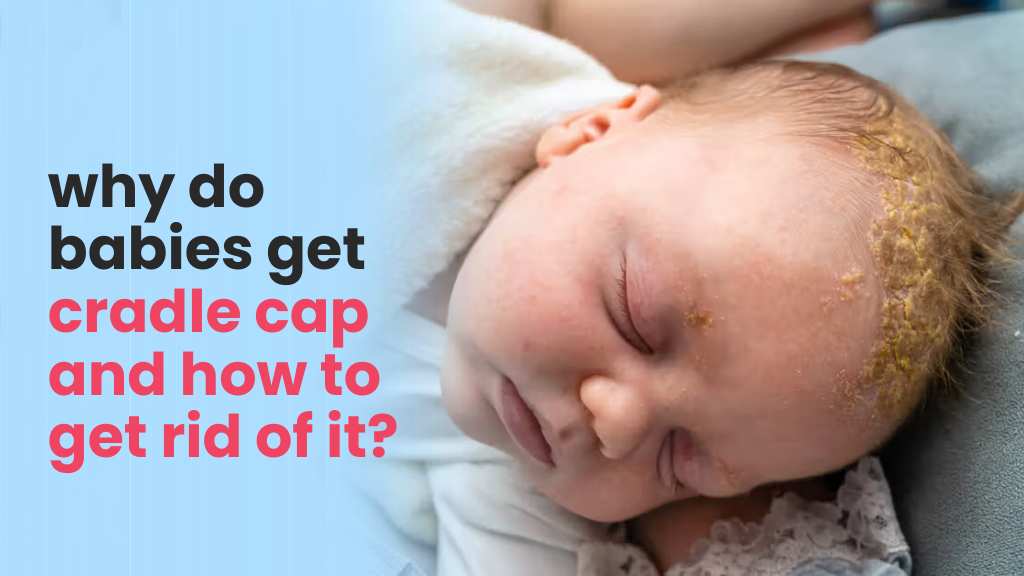
Table of Contents
Cradle cap, medically known as infantile seborrheic dermatitis, is a common occurrence in newborns and young infants. While it may cause concern for parents seeing their baby’s scalp covered in oily, yellowish scales, cradle cap is typically harmless and tends to resolve on its own with time. Understanding the causes, symptoms, and treatment options for cradle cap can help parents effectively manage this condition and alleviate any worries they may have.
Why Do Babies Get Cradle Cap?
Let’s get to why do babies get cradle cap. Cradle cap is believed to be caused by a combination of factors, including the overproduction of oil (sebum) on the baby’s scalp. This excess oil can result from the lingering presence of maternal hormones in the baby’s bloodstream after birth. Additionally, an overreaction of the baby’s immune system to yeast on the scalp can contribute to inflammation, further exacerbating the condition.
Symptoms of Cradle Cap
The hallmark symptom of baby cradle cap is the presence of oily or waxy scales or crusts on the baby’s scalp. These scales may also extend to other areas such as the eyebrows, behind the ears, or even the torso. While the affected skin may appear inflamed or irritated, cradle cap itself is typically not itchy or painful for the baby.
Cradle Cap Treatment
In most cases, baby cradle cap resolves on its own within a few months as the baby’s oil production normalizes. However, if parents wish to expedite the process or alleviate the appearance of scales, gentle measures can be taken. Massaging the baby’s scalp with baby oil or petroleum jelly followed by washing with a mild baby shampoo can help soften and loosen the scales. It’s crucial to avoid forcibly removing the scales, as this can cause irritation and potentially lead to bleeding.
Parents should consult a healthcare professional if the condition persists or is particularly inflamed. In such cases, a doctor may prescribe a mild corticosteroid and anti-yeast cream to reduce inflammation and promote healing. Additionally, over-the-counter anti-dandruff shampoos may be recommended, although caution should be exercised to prevent irritation, especially in sensitive baby skin.
Studies on Baby Cradle Cap
There was a study conducted on infantile seborrhoeic dermatitis (ISD) to evaluate interventions for children aged birth to 24 months. Six randomized controlled trials (RCTs) involving 310 children were included, predominantly under seven months old and mostly boys. However, evidence quality was very low, and uncertainty remains regarding the effectiveness and safety of treatments. Further well-conducted trials with standardized outcome measures are needed, particularly focusing on commonly used treatments such as emollients, antifungals, or steroids, in primary care settings.
When to Seek Medical Attention?
While cradle cap usually does not require medical intervention, but if you want to know how to get rid of cradle cap permanently, parents should consult a doctor if the condition does not improve after a couple of weeks of home treatment, if there are signs of infection (such as weeping or spreading rash), or if the baby seems bothered by the cradle cap.
Prognosis
The cradle cap in babies typically clears up by 6-12 months of age as the baby’s oil production stabilizes. Recurrence after treatment is common but should not cause undue concern, as the condition tends to resolve with time.
Conclusion - How To Get Rid of Cradle Cap in Babies
Cradle cap in babies is a common and benign condition that affects many newborns and young infants. While it may cause worry for parents, understanding the causes, symptoms, and treatment options can help alleviate concerns and effectively manage the condition. By following gentle measures at home and seeking medical advice when necessary, parents can ensure their baby’s comfort and well-being as they navigate through this transient phase of infancy.






